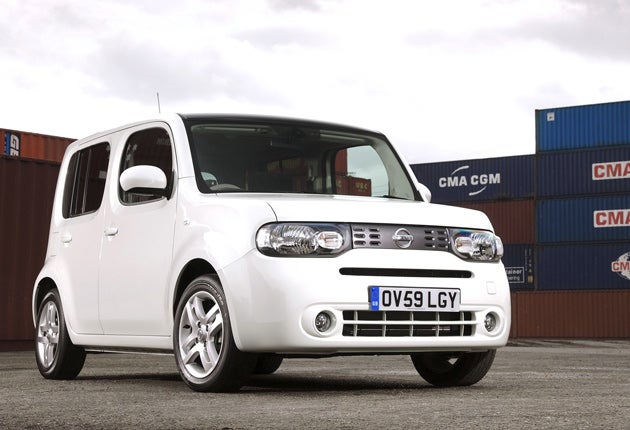Nissan Cube
Nissan's whacky little hatchback is a long-standing cult hit in Japan and it rides like those fun French cars used to

Your support helps us to tell the story
From reproductive rights to climate change to Big Tech, The Independent is on the ground when the story is developing. Whether it's investigating the financials of Elon Musk's pro-Trump PAC or producing our latest documentary, 'The A Word', which shines a light on the American women fighting for reproductive rights, we know how important it is to parse out the facts from the messaging.
At such a critical moment in US history, we need reporters on the ground. Your donation allows us to keep sending journalists to speak to both sides of the story.
The Independent is trusted by Americans across the entire political spectrum. And unlike many other quality news outlets, we choose not to lock Americans out of our reporting and analysis with paywalls. We believe quality journalism should be available to everyone, paid for by those who can afford it.
Your support makes all the difference.Have you ever driven a fridge? I have now – a fridge on wheels – the metaphor failing only because the Nissan Cube has a very good heater as well as an effective air-conditioning system. None of this is meant as an insult. If a car is white and named Cube, then it surely invites such comparisons.
You might, at this point, be wondering why you should want such a car. On a practical level, it's as roomy as a car can reasonably be for a given amount of road space. And there's something pleasingly anti-beauty, anti-sensual about it. Here is the car as emotionally primordial object, the car as it might be drawn by a young child, with its rounded windows set in an angular, naive outline.
The Japanese have long had a subculture of cubist cars (Suzuki Wagon R, Daihatsu Move, Honda Element and two previous Cubes, to name a few). The Cube is even more cubist than most, flouting convention by carrying the impression of glazing on its left side round the rear corner and into the rear window, itself set into an asymmetric rear hatch.
Inside, Cubism gives way to waves, as you enter what Nissan describes as the "Jacuzzi lounge". The seats are broad and soft, the idea being to evoke the notion of sitting on a sofa as water laps around you. So the dashboard, in plan view, has a wave shape and various circular motifs – loudspeakers, cup-holders, a large section of the roof lining – with concentric circles as if a water droplet has struck the centre.
There's a slight hippy vibe here, more evident in the limited-edition LDN version which has crushed-velour seating in a strange mixing of metaphors (won't the velour get wet?), but my test car made do with with a circular shag-pile mat atop the dashboard. Being objective, however, the Cube isn't as clever as it seems. Achieving the expected acreage of rear legroom demands that you slide the back seat rearward, encroaching on already minimal boot space. Moreover, the seat can't be folded fully forward to maximise load space, instead merely allowing the backrest to fold down against the cushion.
There is no proper rear shelf, only a hammock-like arrangement attached with Velcro. And for such a boxy, airy car to have so little storage for oddments is surprising, although the elastic bands on the doors are a novel way of retaining a mobile phone. The "shoji" panels in the glass roof are fun, though, giving a diffused, gentle light.
In Japan, the Cube has been a cult car for a decade. The previous model pioneered the asymmetric look, and fitted perfectly with Tokyo's trendier territories. The new one (at £16,300 – the range starts at £14,000) is a reinterpretation of that idea, and naturally it has a powerful stereo to help the ambience. To assess the Cube on normal extra-urban roads, then, is almost to miss the point, but clearly it has to cope with such use.
It does so, surprisingly well. Under its wacky skin are the underpinnings of Nissans Micra and Note, and, to a degree, their European cousin, the Renault Clio. It rides the way French cars used to: smooth, supple and languid. This and the cartoon looks make for a de-stressing driving experience, yet the Cube can be hurried along if required. It stays steady in corners, and the engine – a 1.6-litre unit with 110bhp, soon to be joined by a 1.5-litre turbodiesel – feels perky if far from potent.
My test car had a continuously variable automatic transmission which worked well, avoiding the tendency of past systems to let the engine rev noisily when one tried to accelerate vigorously. You simply put it in gear and leave it to its own devices. It is, however, slower and thirstier than a manual.
This being the high-specification Kaizen version, it featured automatic windscreen wipers with unusually hopeless intuition, plus a rear parking camera, which you would think unnecessary given the Cube's vertical tail and ample glass area. But this is a car in which the absurd coexists happily with the rational. Its creators have taken a fresh look at what we want and need in a car, and you have to admire their solution.
The Rivals
Citroen C3 Picasso 1.6 Exclusive: from £16,595.
Another essentially boxy car with rounded corners, it's roomy, practical and delightful to drive. Top models are plush, too.
Kia Soul 1.6 Tempest/Shaker: £13,620.
Two different outfits for Kia's compact MPV with quasi-military looks. Steering feels sticky and it's noisy at speed but good value.
Skoda Roomster 1.6 SE: £13,270.
Strange-looking compact MPV. Grew from a sports-car styling sketch, but built with quality. Roomy, practical and pleasing to drive. Good value.
Join our commenting forum
Join thought-provoking conversations, follow other Independent readers and see their replies
Comments